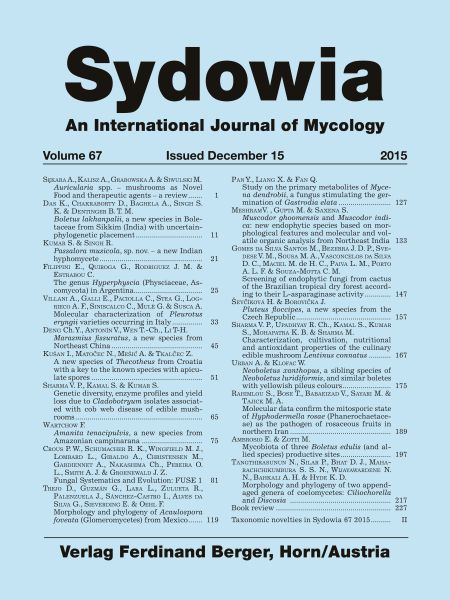
Sydowia Vol. 67/E-Book/S 65-74
Genetic diversity, enzyme profiles and yield loss due to Cladobotr
Download-Artikel
Artikel Nr 2436
Preis 9,30 €
Lieferstatus 

Buchbeschreibung
In: Sydowia 67 (2015): 65–74 DOI 10.12905/0380.sydowia67-2015-0065Genetic diversity, enzyme profiles and yield loss due to Cladobotryum isolates associated with cob web disease of edible mushrooms
Ved Parkash Sharma, Shwet Kamal & Satish Kumar
Cladobotryum species associated with cobweb disease of edible mushrooms were isolated from basidiomata of Agaricus bisporus, Calocybe indica and Pleurotus sajor-caju. Cobweb disease of mushrooms is characterized by the growth of coarse mycelium covering affected mushrooms. The microscopic examination of cultures revealed considerable differences in the fungal morphology but failed to identify Cladobotryum species. The nucleotide sequence comparisons of 5.8S rRNA gene using BLAST network services against NCBI data bases facilitated molecular identification and genetic cataloguing of 15 Cladobotryum isolates into three taxa namely, Cladobotryum dendroides , C. mycophilum and C. asterophorum. The RAPD primers exhibited both inter- and intra-specific variations among the test isolates and separated them into seven distinct phylogenetic sub-clades. Extracellular enzymes assays of ten isolates of Cladobotryum associated with different edible mushrooms revealed variable enzyme activity and it could be observed that higher chitinase and pectinase enzyme assays caused higher yield losses in mushroom crop. The present studies underline the potential threat of cobweb disease in cultivated mushrooms and show significant intraspecific diversity in isolates of all Cladobotryum dendroides, C. mycophilum and C. astrophorum.
Key words: Mushroom diseases, phylogeny, extracellular enzymes, yield loss.
Sharma V. P., Kamal S. & Kumar S. (2015) Genetic diversity, enzyme profiles and yield loss due to Cladobotryum isolates associated with cob web disease of edible mushrooms. Sydowia 67: 65–74.




